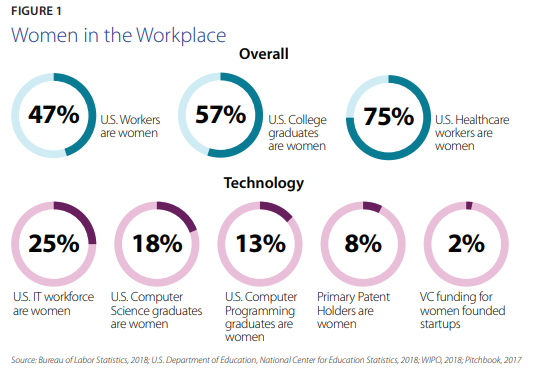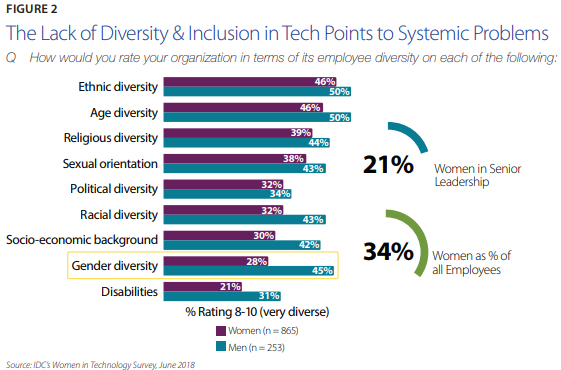In the United States today, women account for 47% of the overall workforce, yet only 25% of IT workers are female according to the Bureau of Labor Statistics (BLS). The tech industry’s efforts to raise the inclusivity of women as employees have been sporadic and inconsistent over the last 50 years, though the issue has certainly gained more notoriety in recent years. Yet despite employers’ efforts to introduce numerous programs to help educate, hire and retain women in technology, women remain significantly underrepresented at all levels.
Fortunately, the tech industry continues to grow at a breathtaking pace and that growth demands faster change. In fact, The BLS lists application software developers and information security analysts among the fastest growing occupations in the U.S. over the next decade (see Figure 1).

Women in Technology Today: a Snapshot
More than 4.5 million U.S. workers are currently employed in a technology role today and the BLS predicts there will be 600,000 new IT jobs by 2026. Over the next eight years, IT jobs are projected to grow at twice the national rate. Women are Minority Employees at Technology Organizations Despite the substantial growth (and need for qualified workers) in the IT workforce, and despite women now accounting for almost half of U.S. workers, they are considered a minority population in technology.
Women are significantly underrepresented in IT jobs and at IT companies. In the U.S., more women now graduate college than men. Last year, 57% of all college graduates were women, yet only 25% of all IT jobs in the U.S. are held by women today. In the U.S., 18% of computer science graduates are women and only 13% of U.S. computer programming graduates are women. Women have significantly less access to cash, capital and funding. Worldwide, only 8% of primary patent holders are women and 2% of VC funding is for women-founded startups.
Women have drastically increased their participation in all aspects of the STEM workforce over the last 50 years, except in technology. In the U.S., women now account for 40-50% of all graduates for medical school, law school and physical sciences, up from rates of 5-15% in the early 1970’s. In U.S., 75% of all healthcare workers today are women. What this means for the technology sector is that the competition for qualified job candidates with technical capabilities has moved to other industries, placing enormous pressure on educating and hiring women for technical and non-technical roles.
Gender Diversity in Technology Organizations Remains Elusive
In a recent survey co-sponsored by IDC and Women in Technology International (WITI), respondents were asked to rate their organization’s employee diversity across nine distinct categories for inclusion such as ethnicity/race, gender, age, sexual orientation, religion, socio-economic standing, politics and disabilities (see Figure 2). No category was rated as “very diverse” by the majority of respondents. Among the nine categories, ethnic diversity had the highest proportion of employees (47%) who considered their organization as “very diverse.” Gender diversity was rated second to last of all nine areas of inclusion with just 31% of respondents viewing their organization as “very gender diverse.”

Diversity and inclusion remain elusive in technology, especially for women. Based on these numbers, gender diversity is nearly at the bottom in terms for major inclusivity measures ratings at technology organizations.
What is most apparent in this data is that men and women perceive the diversity of their organization very differently. Men are much more likely than women to view their organization as very diverse across all nine areas of inclusivity. It’s notable that the greatest area of difference in opinion is for gender diversity. While there is an abundance of publicly available industry data and employment reports that demonstrate women are substantially underrepresented in technology roles and at technology companies, men are far less likely to perceive that gender inequality exists at their organization. This is a major hurdle to improving or achieving gender parity for several reasons.
So how should organizations begin tackling this disparity? Explore some of the solutions that IDC and WITI believe are crucial to improving the numbers of women in technology in our next blog post.
Learn more about the issues facing women in technology and IDC’s ongoing research on the subject; see our latest infographic to learn how unconscious bias hurts women in technology.




